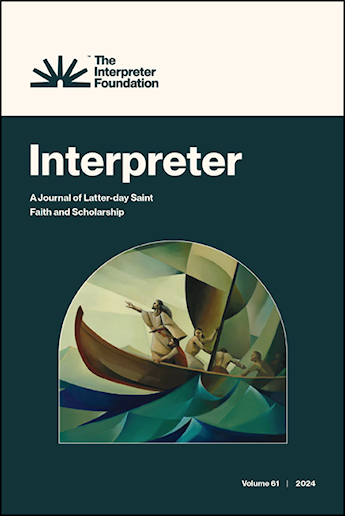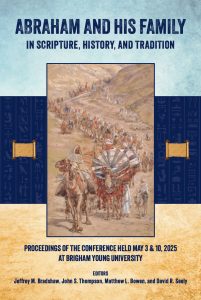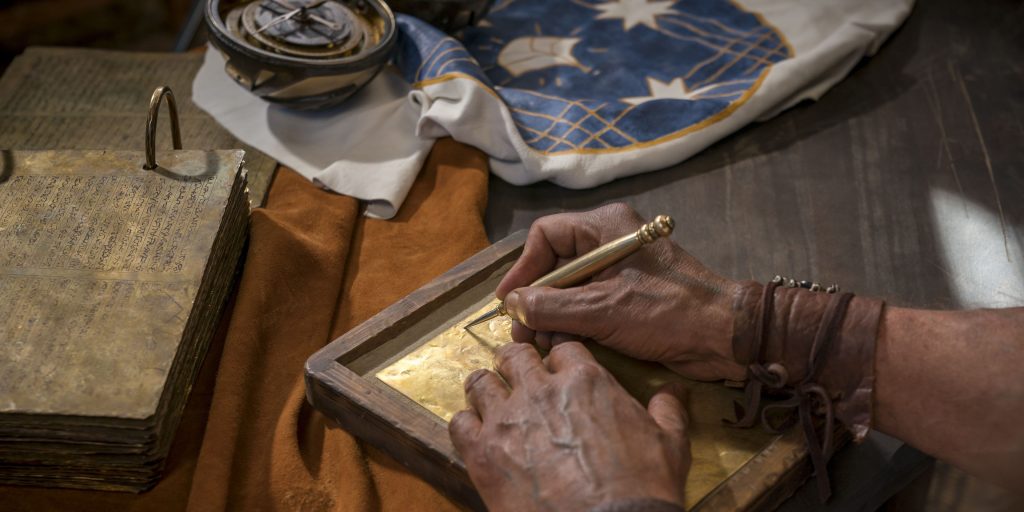Abstract: The symbolic image of the Lamb of God is well-known in the New Testament and The Testaments of the Twelve Patriarchs. This image derives from the Old Testament, later adopted by early Christians. Words of Gad the Seer is an apocalyptic pseudepigraphal book written in pseudo-biblical Hebrew from a manuscript copied in the eighteenth century. After over thirty-three years of investigation, many aspects of this recently discovered text are coming to light. There are more than twenty similarities between this largely unknown book and the book of Revelation, though one was written by a Jewish man who became Christian and the other by a (non-rabbinic) Jew. This old yet newly discovered book will be presented briefly, and the concept of the Heavenly Altar and the song of the Lamb will be discussed. Some esoteric traditions’ pseudepigraphic, rabbinic, and Hekhalot literature will be presented concerning what is sacrificed on the Heavenly Altar or goes up to God, giving the heavenly world a new look. The relationship of the Song of the Lamb to Revelation 15:3 and Jewish liturgy is also explored.
 Welcome to Interpreter: A Journal of Latter-day Saint Faith and Scholarship, the peer-reviewed journal of The Interpreter Foundation, a nonprofit, independent, educational organization focused on the scriptures of The Church of Jesus Christ of Latter-day Saints. Non-print versions of our journal are available free of charge, with our goal to increase understanding of scripture. Our latest papers can be found below.
Welcome to Interpreter: A Journal of Latter-day Saint Faith and Scholarship, the peer-reviewed journal of The Interpreter Foundation, a nonprofit, independent, educational organization focused on the scriptures of The Church of Jesus Christ of Latter-day Saints. Non-print versions of our journal are available free of charge, with our goal to increase understanding of scripture. Our latest papers can be found below.
Interpreter's Mission Statement →
Read the journal →
Learn more about the Board →
Find out how you can donate →
Contact the Editorial Board →

Church History and Great Britain with the Interpreter Foundation 14-Day Land Tour escorted by Dan Peterson, Kristine Frederickson, and Peter Fagg May 6-19, 2026 This tour will sell out fast so book your reservation now! Go to https://interpreterfoundation.org/study-travel/britain-2026/ for more information |
|
Abraham and His Family in Scripture, History, and Tradition Proceedings of the Conference held May 3 & 10, 2025 at Brigham Young University Sponsored by The Interpreter Foundation, Edited by Jeffrey M. Bradshaw, John S. Thompson, Matthew L. Bowen, & David R. Seely Published by The Interpreter Foundation and Eborn Books For more information, go to https://interpreterfoundation.org/books/abraham-and-his-family/ |
|
Call for Proposals “For a Wise Purpose in Him” Perspectives on the Small Plates of Nephi A Conference on the Small Plates of Nephi in the Book of Mormon May 29-30, 2026 Sponsored byThe Interpreter Foundation Go to https://interpreterfoundation.org/conferences/2026-small-plates-of-nephi/ for more information |
The Lamb of God: A Note on the Significance of Meir Bar-Ilan’s Paper for Latter-day Saints
Abstract: Dr. Meir Bar-Ilan’s paper, “The Heavenly Lamb, Sacrifices on the Heavenly Altar, and the Song of the Lamb,” appearing concurrently in Interpreter, is a welcome contribution from a noted Jewish scholar. Bar-Ilan has called the world’s attention to a remarkable Hebrew manuscript with origins in antiquity, Words of Gad the Seer. Those interested in the relationship between Jewish texts and Latter-day Saint scriptures may also wish to compare the findings in Bar-Ilan’s paper with treatments of the Lamb of God in the Book of Mormon and the Book of Moses.
“When Ye Shall Rend That Veil of Unbelief”: A Typological Reading of Ether 3 and 4
Abstract: In the book of Ether, the prophet Moroni “Christianizes” the Jaredite story, inserting extensive Christian elements into an original text that predates the house of Israel, the Nephite nation, and the Christian era. In this paper, a typological and intertextual method is used to show how Moroni uses the words of Christ in Ether 3 and 4 to exhort his Gentile readers to embrace the Nephite record when it is manifest to them that they might receive even greater things (divine truths). Specifically, Moroni uses the brief account of the brother of Jared atop Mount Shelem to illustrate how Gentiles may “rend the veil of unbelief” and gain perfect knowledge of all things ever revealed. As the Lord revealed his finger to the brother of Jared, so also the Book of Mormon, itself a portion of the word of the Lord, will come forth to try their faith. Those Gentiles who believe and come to know with perfectness of its truthfulness are positioned to lay hold of even greater things than these through Christ. The value of this reading is to clarify Moroni’s effort to adapt the early Jaredite history to a later event—the coming forth of the Book of Mormon and its implications.
The Flimsiest Show on Earth
Review of Lars Nielsen, How the Book of Mormon Came to Pass: The Second Greatest Show on Earth (Minnetonka, MN: self-pub., 2024). 390 pages. $19.95.
Abstract: Every so often an anti-Mormon book comes along that lowers the bar for attacks on the faith. How the Book of Mormon Came to Pass is one such work. It relies on speculation, conjecture, and tenuous connections to render, out of whole cloth, a hypothesis for the Book of Mormon’s creation that is almost laughable.
The Literary Structure of Alma 23–27
Abstract: This article presents a macro-chiasm for Alma 23:16 through Alma 27:30 that covers the account of the people of Anti-Nephi-Lehi from the time they first take upon themselves that name to the time they relocate to the Nephite land of Jershon and are subsequently called the people of Ammon. The central element of this chiasm highlights the martyrdom of some Lamanite believers in the wilderness by the hand of the seed of Amulon in fulfillment of Abinadi’s prophecy in Mosiah 17:15. The meaning behind this puzzling prophecy may be illuminated by analyzing the structure of this macro-chiasm. It underscores the role Alma 26 plays as a strategic interruption in the narrative, much like how Alma 36–42 disrupts the story of the Zoramites. Events within the account of the people of Anti-Nephi-Lehi were carefully crafted by Mormon and purposefully placed within the narrative to form a memorable foundation story justifying the acceptance and integration of the people of Ammon into Nephite society both religiously and politically. The same criteria previously used to measure the strength of a proposed chiasm are employed here.
Prepping for the Last Battle
Abstract: Intellectually acute, deeply learned, brilliantly imaginative, yet popular and easily accessible, C. S. Lewis was arguably the greatest Christian apologist of at least the past century. I believe that Latter-day Saints can benefit greatly from reading him and re-reading him and that those who are unfamiliar with his writing have an enviable treat awaiting them. I’m also convinced, by my own experience, that those who return to his work after having read some of it once, long ago, will find his books at least as good as they seemed on first acquaintance. In fact, they may even find, as I did, that they’re even better than they had realized. This essay is a shameless plug for a great and greatly admired writer.
Perspectives on the Soteriological Problem of Evil: Nuancing the “Universalist” Theologies of Henri de Lubac and Joseph Smith
Abstract: Since the discovery of the new world by Christian European explorers during the age of discovery, the increasingly global community of the modern age has confronted Christian theologians with difficult soteriological questions. These questions have caused many Christian adherents to abandon conceptions of a uniquely Christian salvation in favor of theological positions of religious pluralism. Other Christian theologians have confronted these issues through creative inclusivist theological constructs that expand the offer of salvation to those who may not have professed Christianity in their mortal life. These inclusivist theologies are uniquely suited to address modern concerns about the salvation of non-believers in a largely un-Christian world, while still maintaining the exclusive Christian claim that salvation comes only through Christ. The inclusivist theologies of Catholic theologian Henri de Lubac and Joseph Smith are investigated and nuanced to display how they maintain a uniquely Christian view of salvation, while expanding traditional conceptions of who will receive access to salvific grace.
“Upon Thy Belly Shalt Thou Go”: The Garden of Eden Serpent Symbology Based on the Concept of Seraphim
Abstract: The concept of the serpentine seraphim from biblical iconography is discussed in the context of biblical serpent symbology. The association of the seraphim with Ancient Near Eastern kings, deities, and temples is noted. The concept of the seraphim as members of the Council of God is explored, and the possibility of the seraph as a symbol of Christ is discussed. These concepts are applied to the story of the snake in the Garden of Eden, and the additional explanatory power of the seraph symbol in connection with the snake is explored. Specific serpentine attributes are discussed in the context of the seed motif. The article concludes with a brief discussion of the application of this topic to the modern reader.
Small Hinges, Great Doorways: How Some Descendants of an Enslaved Youth Unexpectedly Became Prominent Utah Citizens
Abstract: A vivid illustration of how “the doorways of history turn on small hinges” is found in the Howell family tradition about Wilford Woodruff’s short stay at the home of slaveholders in the South, where it appears he may have taught a 14-year-old enslaved boy named Jackson Howell. Decades later, Jackson’s son Paul C. Howell would migrate to Utah and become a prominent citizen of Salt Lake City. Later, Paul’s son, Abner, would serve a unique mission and would continue to speak and serve in the Church. Several Church leaders played a key role in the story of the Howell family throughout the years when priesthood and temple restrictions remained in place.
“Our Hands Have Handled”: Ensuring the Reassuring Doctrine of the Resurrection in the Lucan and Johannine Writings
Abstract: The Lucan and Johannine writings emphasize the literalness and physicality of the resurrection of Jesus Christ. This emphasis does not represent an emerging Christology from an earlier, inchoate conception of Jesus and the meaning of his life. Rather, it reflects an effort to defend the doctrine of the resurrection—of Christ and humanity—against the increasing cultural and intellectual pressures of middle Platonism. Nephi’s vision of the tree of life, which included seeing a “great and abominable church” and its formation among “the nations of the Gentiles” (1 Nephi 13:4–9) matches well with late first- and second-century apostate movements that “made war” with the saints and “overcame” many of them (Revelation 13:7). A conspicuous feature of some movements at that time is the denial of the literal, physically resurrected Jesus Christ and the resurrection of all humanity from the dead. The widespread distortion of Christ’s resurrection and opposition to the concept of bodily resurrection continues to the present.
Looking Again at the Anthon Transcript(s)
Abstract: The official account of Martin Harris’s visit to Charles Anthon, canonized in the Pearl of Great Price, suggests that Anthon may have been shown more than one transcript by Harris. The differing responses of Anthon to each of these transcripts may shed light on the kinds of characters he was shown and provide additional perspectives that can help clarify a little more what is happening in the historical sources.
The “Allegory” of Ruth as a Prophecy of Latter-day Gathering
Abstract: In the historical context of the late fifth century BC, the book of Ruth was a powerful story of hope and redemption for the eventual gathering and restoration of Israel’s covenants. Connecting their golden period of unity under King David to this idyllic tale with a beautiful happy ending may be more than a family story. It could also be read allegorically to prophesy the promised gathering of Israel by the Gentiles in the Latter-days. The key to understanding the symbolic layer of this story lies in deciphering the Hebrew meanings of the characters’ names, with Naomi representing the Israelites, and Ruth the Gentiles. Doing so unlocks the messages in the story of the Gentiles gathering Israel, the marriage relationship of Christ and the Church, and the promise of a Millennial Messiah. Exploring the connection of the book of Ruth, Pentecost, and harvest themes adds more significance to this allegory.
Ring in the Christ that Is to Be: Fulfilling the Pattern of His Life
Abstract: The story of Christ, and of Christmas, is the story of Christ “the Lord God Omnipotent” incarnating in “a tabernacle of clay” (Mosiah 3:5). Christ took upon himself flesh so that he might also take upon himself burdens that he did not naturally have to bear—our burdens—in order to relieve us of those burdens. Christ, according to the scriptures, voluntarily “takes upon him” our pains, our sicknesses, death, our infirmities, and our sins (Alma 7:7–13). Unlike Christ, ordinary human beings do not “take upon them death” and bodily infirmity, but are, like king Benjamin, “subject to” them (Mosiah 2:11). In voluntarily taking upon himself our burdens, Christ brought redemption to us, and provided a pattern for us to live by. When we choose to bear burdens that we do not by nature or by necessity have to bear, we emulate him. Paul referred to following this pattern as living by “the law of Christ” (Galatians 6:2), and, as Alma’s teachings at the Waters of Mormon indicate, we covenant at baptism that we will live this pattern with one another—to “bear one another’s burdens, that they may be light” (Mosiah 18:8–10). In so doing, we live as part of the body of Christ, measurably living out and incarnating our heavenly King in this world.
Finding Nephi’s Ore
Abstract: Khor Kharfot and Wadi Sayq are in the region that has become the premiere candidate for Nephi’s Old-World Bountiful. Out of the several matching criteria that has led to this opinion, the one that may be the weakest has been the identification of readily available ore in the area that Nephi could have used to manufacture the tools necessary to build his ship. This investigation, conducted in February 2023, found several distinct examples of iron ores suitable for ”smelting” in the form of float, all pointing to deposits yet to be located. Additionally, I review the investigation of Dr. Revell Phillips, who headed a group from BYU in 2000, that found two locations north of Khor Kharfot apparently containing significant deposits of iron ore. However, one site turned out to be problematic and the other site is too distant for Nephi to have been able to access it. Nonetheless, their efforts are reviewed as a backdrop for this current study. Also presented are findings regarding heretofore unrecognized features of Wadi Sayq and Khor Kharfot and the likely conditions that produced them, going back into the Pleistocene era.
What Can Artificial Intelligence Tell Us About the Literary Skills Needed to Dictate a Text Like the Book of Mormon?
Abstract: The first oral draft of the Book of Mormon dictated by Joseph Smith reflected remarkable literary refinement and complexity. Such observations demonstrate that he exhibited highly developed composition and oratory skills. To date, no scholar has attempted to describe the specific skills Joseph manifested while dictating. This essay addresses whether Artificial Intelligence (AI) could generate an accurate list of the skills necessary. It begins by identifying and informally testing eleven chatbots to see if they can accurately predict the skills needed to perform a task. Seeing success, they are next asked a long question about the skills needed to dictate a book like the Book of Mormon. Fifteen skills are common in the responses from the eleven chatbots, which are compiled into a list. The list is then validated by appealing to experts in the field of literary composition. Next, his documentable 1829 skills are cross-referenced to the list. The historical reality is that none of Joseph’s personal acquaintances describe him as accomplished with the skills that AI calculated would be needed. This AI “fail” deserves additional investigation. If eyewitnesses accurately reported he lacked the predicted skills, what skills did AI miss and what skills enabled him to dictate the Book of Mormon?
What Happened to Nephi at the Camp of the Broken Bow? A Book of Mormon Mystery
Abstract: Nephi started as the youngest son of Lehi and Sariah and ended up as the king or king-like leader of the Nephite nation. While he, in some sense, obviously grew into the role over time, there was likely some key time or event when the transition from the leadership guidance of the prophet Lehi transferred to the restrained leadership guidance of his son, Nephi. A low-key leadership style was necessitated by the absolute imperative that the group be held together. This article briefly discusses four possible time frames for that transition but favors the idea that it happened in an area often called “the Camp of the Broken Bow.” This choice is based on (1) the symbolic meaning of Nephi breaking his bow, (2) the importance of Lehi murmuring “against his God,” (3) Nephi’s ascension to the “top of a mountain,” and (4) the subsequent near disappearance of Lehi from the narrative. These four critical events all occurred at the Camp of the Broken Bow. Evidence appears to suggest that it may have been at that time that there was a replacement of Lehi’s tenure, not as a prophet, but as the recognized leader of the expedition.
Through a Glass Darkly: Restoring Translation to the Restoration?
Review of James W. Lucas and Jonathan E. Neville, By Means of the Urim & Thummim: Restoring Translation to the Restoration (Cottonwood Heights, UT: Digital Legend Press & Publishing, 2023). 288 pages. $19.95.
Abstract: In By Means of the Urim & Thummim, James Lucas and Jonathan Neville valiantly seek to defend Joseph Smith’s role as the divinely inspired translator, a role that they argue is incompatible with using any tool other than the Nephite “intepreters,” later called the Urim and Thummim. They offer a unique theory to account for the statements of witnesses about Joseph using a seer stone in a hat, arguing that it was a fake demonstration using memorized passages to satisfy onlooker curiosity about the translation process. They propose a translation model in which Joseph did more than just get impressions, but saw an incomplete or literal translation in the Urim and Thummim that left plenty of room for heavy mental effort to turn what he saw into acceptable English. While the authors seek to defend Joseph from what they view as the questionable theories of modern Church scholars, their misunderstanding and misinterpretation of both the historical record and scripture result in some errant assumptions and logical gaps that undermine their well-intentioned work.
Trust Us, We’re Lawyers: Lucas and Neville on the Translation of the Book of Mormon
Review of James W. Lucas and Jonathan E. Neville, By Means of the Urim & Thummim: Restoring Translation to the Restoration (Cottonwood Heights, UT: Digital Legend Press & Publishing, 2023). 288 pages. $19.95.
Abstract: In their book, James Lucas and Jonathan Neville present two major theses relative to translation of the Book of Mormon. The first is that the translation was always done by means of the interpreters that were delivered with the plates. The second is that Joseph Smith was an active participant in the translation process. A theory is laid out for how that might happen. Although this reviewer can agree that Joseph was an active participant in the translation, neither the first thesis nor their explanation of the second thesis can be accepted by those familiar with the historical record.
A Closer Look at Transliterations in Divine Translations
Abstract: The Book of Mormon contains many words left untranslated by Joseph Smith, such as cureloms, cumoms, senine, and ziff. While some might wonder why these words are left untranslated, a closer examination of the kinds of words that are simply transliterated as well as the frequency at which these phenomena occur provide evidence that Joseph Smith actually had an ancient record that he was translating into English. In this paper, I examine why some words have been transliterated in historical translations of the Bible or other ancient texts and compare these explanations to the Book of Mormon. In the end, I show that the Book of Mormon consistently transliterates the same types of words typically left untranslated in other works in ways that would have been unknown to Joseph Smith.
A Plain Exposition of Book of Mormon English by Means of Short Questions and Informed Answers
Abstract: Because many questions have arisen regarding the discovery of real early modern influence in the dictated language of the Book of Mormon, some of these are considered and answered in this essay. The answers reflect insights from an exploration of the data that drove the conclusions published in previous papers. Numerous considerations independently indicate that the Book of Mormon was dictated in language that cannot be explained as a mere imitation of King James linguistic style, nor as Joseph Smith’s Yankee dialect. While the reasons for this and the processes that may have led to such results are open for debate, the implications of the data themselves cannot be lightly brushed aside.



 Conference Proceedings are now available
Conference Proceedings are now available